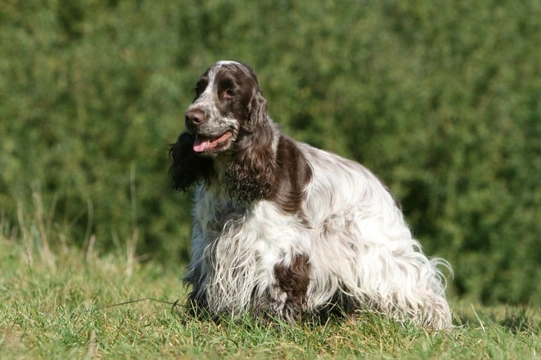
The Lovely Parti-coloured Cocker Spaniel
Cocker Spaniels are lovely characters and for decades they have been among the most popular dogs to keep both as family pets and to use as gun dogs. Often referred to as very personable and fun loving characters, Cocker Spaniels are a real pleasure to have around, but they do need to be kept busy to be really happy because if they are not, they may well develop some unwanted behavioural problems.
There are many colour and coat variations within the breed, but it's the particoloured coats that are among the most appealing. However, puppies are not born with any ticking because this only develops over the following weeks after their birth and it continues to get stronger as puppies mature into adulthood.
The breed standard for colour variations is defined as follows:
- Various. In solid colours no white is permitted except on a dog's chest
With such a vast range of colours and coat variations, these lovely dogs fall into two categories which are dogs with solid coloured coats and those with parti-coloureds and these are defined as follows:
- Blue roan is created by black flecking in the dog's coat
- Liver/chocolate roan is created by liver/chocolate flecking in the coat
- Orange roan is created by the orange fleck in a dog's coat
Among the most popular parti-coloured variations are the “roans” which can range from light roan right through to a much darker roan. It's the flecks of a dog's dominant coat colour that creates the roaning in their coats. Closing following the blue roan parti-coloured Cocker is the charming orange roan with the liver/chocolate coming in third. But with this said, over recent times all three of these variations are becoming more popular than ever before.
The “And Whites”
Cockers with coats that have some white in them are referred to as “and whites” which describes the fact they have either large or small patches of white in their coats. The most popular being the black “and white” which is closely followed by the orange and white. Last but not least is the liver and white, but again over time, more people are being drawn to the latter two variations than ever before.
The “And Tans”
Cockers that have very defined tan patches above their eyes and with an amount of flecking on and around their muzzles, inside their ears and on their legs as well as their feet and lastly a little under their tails are referred to as “and tans”.
The most popular are both the white “and tan” together with the blue roan “and tan”. These are closely followed by the liver/chocolate, white and tan parti-coloured Cockers. Dogs with these colourings are called 'tri-coloured'.
All parti-coloured Cockers have a solid main colour on their ears, on either side of their heads as well as at the base of their tails. These solid patches and markings can be seen in either large or smaller sections anywhere on their bodies, necks, legs and hindquarters.
There are no defined markings in the breed standard for parti-coloured Cocker Spaniels so in truth none of these charming dogs can be thought of as having incorrect or unattractive markings.
Puppies Are Not Born With any Ticking
Because Cocker Spaniel puppies are not born with their markings which, as previously mentioned develop over the weeks following their birth, the only way to establish they are in fact parti-coloured, is by checking their paw pads. If the puppies are blue roans or orange roans, their paw pads would be dark in colour.
However, blue roans and orange roan puppies with black pigmentation would have black paw pads. Liver/chocolate roans and orange roan puppies with liver pigmentation would have brown pads. When it comes to the “and whites”, their pads would be partly dark in colour. Other variations would be as follows:
- Black and whites with black pigmentation would have black and pink pads
- Black with black pigmentation would have black and pink pads
- White and tans with black pigmentation would have black and pink pads
- Orange and whites with black pigmentation would have black and pink pads
Conclusion
Over the years more people have come to appreciate the wonderful markings and variations found in parti-coloured Cocker Spaniels which is hardly surprising because their colouring adds so much character to an already charming dog. Cockers with lots of flecking in their coats are very attractive looking dogs, but then so are the dogs that only boast a little flecking and larger patches of solid colour. These wonderful markings accentuate the athletic look of what has become one of the most popular choices of family pets on the planet, not forgetting the fact they are supreme gun dogs too!



